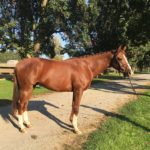As promised, wanted to give an idea of what is involved in conditioning a horse for Endurance, and more specifically the Tevis Cup.
My experience in getting horses ready for the 100-mile-in-one-day feat has been under the auspices of several well-respected horse owners and trainers.? They share many of the same ideas and techniques, so I’ll kind of do a collective summary.
Before you attempt Tevis on a given horse, you generally want to have successfully checked off most of the following tasks (this is assuming you have an experienced endurance horse as a starting point – one that has been competing for two-three years);
- If the horse has never done 100 miles, doing an easier version before you try Tevis – to expose them to the distance – is advisable
- Complete – in good form – at least two 50-mile rides in the four months prior
- If possible, do a 75-mile ride at least eight weeks prior to Tevis to stretch the horse’s conditioning/capacity
- Pre-ride the Tevis trail – cover as much of it as you can in the direction the ride goes so that the horse?(a) has seen the trail and understands there is a destination to be reached and (b) is awake to the care they need to take in placing their hooves on the challenging and technical portions (if your horse has done the ride before, this is less important – they have an amazing capacity to remember trail)
Conditioning the horse so you can check off these boxes and hopefully finish Tevis involves several different techniques;
- Long distance rides – we might do as many as 30 miles in a conditioning ride.? Typically these longer rides are interspersed with the 50-mile competitive rides mentioned above and we want to give the horses at least a day for every ten miles covered to relax and recover afterward.
- Shorter, more intense rides – for example, a 15 mile ride that involves three long hill-climbs that we cover at speed.? Our version of interval training, these rides are intentionally designed to push the horse’s cardiovascular conditioning to the next level.
- Shorter, more relaxed fun rides.? Horses can get stale and burned out if all you do is saddle them up and work them to the bone.? So we also plan lighter rides on trails that they like (you can tell which ones they prefer, generally those without lots of hills that they can move out on are the faves – the Coast Trail at Point Reyes National Seashore is a good example of a horse-preferred trail).
As you spend innumerable hours on a given horse, you get a very good understanding of their fitness level. You have a front seat to the improvements they make over time, how from week to week they can trot further up that killer hill or they recover more quickly after that mile-long gallop.? Using a heart rate monitor is a more scientific and informed way to condition your horse and there is plenty of reading one can do about what is the horse’s working range (generally held to be between 140 and 160 bpm) and when they become anaerobic (190 – 200 bpm).?
I’ve found that the HRM is most useful during competition with certain horses.? The equine can be a very competitive animal – even to a seemingly-insane level -?and they absolutely know when we are racing versus just riding for conditioning.? In the heat of the moment, they can mask their level of fatigue in order to catch that next horse up the trail.? A HRM helps you tell the difference and see the truth of the situation before it becomes to late.? But you need to have been using it in training so that you know your horse’s?working range and anaerobic range.
This rating ability becomes exponentially more important when you need enough horse to carry you for 15 or 20 hours in a day along extremely challenging trail.? And the start of Tevis is chaos.?
Despite efforts to introduce sanity, it is essentially a mass start of 200+ horses on a fire road in the high Sierra woods.? Did I mention the mules?? There are always a handful in the field and something about that nervous, teeming mass of equine flesh inspires them to bray loudly in the cold, pre-dawn air.? The rest of the creatures in the area – human, horse and I’m betting a good number of woodland inhabitants – jump out of their skin.







